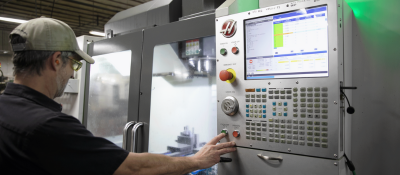Your Cart is Empty

Benefits of Air System Audits: What, When & How
A detailed compressed air energy audit examines the function and energy performance of a compressed air system with data collection as a core feature. Energy audits with data logging are a proven and powerful tool to solve complex problems and save energy, with positive results directly affecting the bottom line.
Written by John Molnar, P.E.
Table of Contents
- What is a Compressed Air Audit?
- Determining if You Need an Air System Audit
- What do You Need to Perform an Audit?
- Analyzing the Air Audit Results
- The Cost of an Energy Air Audit
- Becoming a Compressed Air Auditor
- How to Find a Compressed Air Auditor
“Without data, you’re just another person with an opinion.”
-W. Edwards Deming
Industrial plants have long used sensors and gauges to monitor and record data critical to plant operation. Sensors were installed permanently and integrated with complex SCATA, MODBUS, and other plant-wide systems using computer servers and control rooms for monitoring. These systems provide critical data; however, after the system is installed, adding additional sensors for secondary energy analysis or troubleshooting of smaller systems, such as compressed air systems, can be cost-prohibitive.
Key Takeaways:
- Air System Audits Uncover Hidden Inefficiencies: Regular audits can reveal issues like leaks, pressure drops, and inappropriate uses of compressed air, which often go unnoticed but significantly impact energy consumption and system performance.
- Timely Audits Prevent Costly Downtime: Conducting audits proactively helps identify potential failures before they lead to unplanned downtime, ensuring continuous operation and reducing emergency repair costs.
- Customized Audits Address Specific Operational Needs: Each facility has unique requirements; tailored audits consider factors like production schedules, equipment types, and usage patterns to provide relevant and actionable insights.
- Data-Driven Recommendations Enhance System Performance: Audits provide measurable data that inform decisions on system upgrades, maintenance schedules, and operational changes, leading to improved efficiency and reliability.
- Regular Audits Support Long-Term Energy Savings: Implementing audit recommendations can lead to substantial energy savings over time, contributing to lower operational costs and a reduced environmental footprint.

Technicians at the Battersea Power Station, London, 1932.
In the last several years, advances in technology have reduced the cost and made it much easier for engineers to gather massive amounts of data with temporary sensors in industrial plants.
With the data logger systems available, collecting data to find energy savings and solve problems with compressed air systems has never been easier.
What is a Compressed Air Audit?
A detailed compressed air energy audit examines the function and energy performance of a compressed air system with data collection as a core feature. With some training and engineering experience, an individual can perform a compressed air audit. The existing system operation is examined and analyzed to create a system baseline. The baseline is the existing state of the system before any changes or upgrades are made. A baseline for your New Year’s resolution to lose weight, for example, would be stepping on the scale on January 1st.
After the baseline system analysis is complete, the data is analyzed using statistical computer models to simulate new operational setpoints to predict energy savings through equipment upgrades. Some energy savings prediction software is readily available. Many energy auditors have built their own proprietary simulation models, including our audit team at Rogers Machinery Company.
The data is typically compiled into a report with the proposed solutions, and energy incentives (if available) are estimated.
When the changes have been made and the upgrades installed, data is collected once again to tune the system and verify the accuracy of the predicted energy savings.
The final step is to set up periodic checks or have permanent sensors installed to ensure the system’s efficiency for years to come.
Determining If You Need an Air System Audit

Usually, the plant engineers are the ultimate deciders of whether the site needs an energy audit, but utilities and power companies have their own goals for energy savings and will seek out industrial sites to introduce energy incentive programs for upgraded equipment. Air compressor salespeople will also facilitate an energy audit to bring together customers with energy incentives to upgrade equipment. Substantial financial incentives are available in many areas to install new equipment with ongoing lowered energy usage.
While most energy audits are started to determine ways to save energy, others are undertaken to find and resolve problems within the system.
In a recent example, a piece of packaging equipment in the far corner of a manufacturing plant was having trouble with low pressure at odd times, while the rest of the machines in the plant seemed to operate fine.
Temporary sensors recording pressure levels at several locations were placed and data logging of the compressors was conducted. The root cause of the pressure problem was determined to be a nearby dust collector consuming large amounts of air over short time periods, causing a pressure drop to the area. A 500-gallon receiver tank was installed near the dust collector, which resolved the low-pressure issue with the packaging equipment.
Another recent example of a system problem happened at a corrugated box factory. During the night shift, the operators were complaining about low compressed air pressure. The smaller night-time compressor usually provided plenty of air for the smaller night-shift production crew at the box plant.
Data logging found that the low-pressure events occurred every 2 hours. A filter backflush diaphragm pump was identified to be on a timer to run every 2 hours and was left on overnight in error.
Sometimes air compressor service departments will have a problem they can’t solve. The problem could be intermittent, occur in the middle of the night, on weekends, or involve multiple pieces of equipment.
Heated desiccant dryers, for example, can take up to 8 hours to complete a full regeneration cycle, and nobody wants to sit there that long to wait and see when it malfunctions. Recording valve positions, heater and blower operation, and tower pressure with data loggers can pinpoint when the trouble happened and what was going on with the dryer.
What do You Need to Perform an Audit?
Once the facility has decided the need for a compressed air audit, it’s time to carry out the audit itself. If you hire someone or do the audit yourself, the process can be broken down into several steps: make a plan, collect data with sensors and data loggers, analyze and present the data, implement the solution.
Create a Plan for the Audit
The first thing needed is a plan. Determine the project goals and clarify the questions you are trying to answer. Are you trying to save energy, fix problems, or find reasons to upgrade equipment?
Determine Data Logging Equipment Needed
Next, spend some time and do a system walk-through to gather the necessary information to determine the required data logging equipment. Gather nameplate data of all the relevant equipment into a list, make a system sketch, and tally the number and types of sensors and data loggers needed and where they should be installed.

A sensor commonly used to perform energy audits is a transducer. A transducer takes a physical or electrical signal and generates a calibrated electrical signal which a data logger can record. Transducers are typically supplied with an AC to DC power supply and are wired into a 4-20mA current loop datalogger. A typical pressure transducer converts a 0-150 psig input to a 4-20 mA output.

Here's a Crash Course on Which Sensor Types You'll Need Based on What You're Trying to Measure:
Amperage is measured using a current transducer, or ‘CT’. They are typically split-core/clamp-on, or ring installed around a wire to record the amperage flowing through a wire. The split-core CTs are preferred because they can be installed around the wire without having to disconnect one end of the wire.

Power or kilowatts can be calculated with only amps, but assumptions must be made for voltage and power factor, which can lead to erroneous calculations unless a spot check of true kW is made at different operational points. The power factor can vary from 0.89 on a fully loaded air compressor to 0.4 with the same compressor in an unloaded state. If only amps are recorded, and the power factor is assumed to be constant, significant errors will be present in the kW calculations if the compressor frequently runs unloaded.

Kilowatt (kW) meters/ transducers record power in kW. True kW meters give the best power data because they measure amperage and voltage and calculate the actual power, power factor and apparent power. The disadvantage of measuring kW is the cost of the meter and the added difficulty of installing voltage probes which require additional safety considerations in electrical panels. If you ever install a power or amp meter, make sure to locate it upstream of any adjustable speed drives.
Temperature can be recorded with an analog thermocouple type sensor. A thermocouple’s resistance varies with temperature. Thermocouples do not require an external power supply but need to be paired with a datalogger specific to the purpose. Temperature transducers are also available with 4-20mA outputs.
Flowmeters are used to measure compressed air flow. Thermal dispersion flowmeters are the most commonly used sensor type for compressed air. They use a stainless-steel probe(s) inserted into the compressed air stream through a hole or a threaded port in the pipe. The probe has a heated element and a sensor element. The meter records the amount of heat transferred between the elements to measure the mass flow, and they are calibrated for pipe size and type of gas.

Thermal dispersion flowmeters require care in installation: the air temperature must be within the proper range. They must be installed after an air dryer, as entrained water droplets in wet air can disrupt the heat transfer between the probes. Flowmeters must also be installed in a straight section of pipe with a specified minimum number of pipe diameters upstream and downstream from the flowmeter to minimize turbulent air flow.
A dewpoint sensor is used to record the pressure dewpoint, that is, the amount of water present in the compressed air. A malfunctioning dryer or leaks can lead to problems with compressed air dewpoint. These problems could be localized to one area, or they might impact the entire system. Moving a dewpoint sensor to different locations during the data logging process will determine if the problem is in one place or everywhere in the system.
Choosing Data Loggers
Once you have identified the necessary sensor types and locations, you’ll need one or more data loggers to record data from all the sensors. A variety of data loggers are available. Cost, flexibility, durability and data storage capacity are factors to consider prior to purchase.
Most data loggers require downloading with a USB cable when they reach capacity. Depending on the number of sensors connected and the data logging interval, the data logger can have several weeks to several months of data logging capacity.

For troubleshooting in rapidly changing systems, 1 to 3-second intervals provide very detailed data. For long-term data logging, 15 seconds to 1-minute intervals can reduce data download frequency. Some data loggers have SIM cards and can be downloaded remotely or can be connected to Wi-Fi.
Decide How Long to Log Data
The decision of how long to data log is often a conundrum. For energy projects, energy usage is typically averaged and projected out as a yearly kWh or yearly dollar cost. Data logging for an entire year is not usually practical. If the plant is stable all day, every day, only 1 day of data is needed to show annual operation. If the plant has seasonal demands, such as a fruit processing facility, data logging could be done twice to record trends at each operational point with weighted averages applied to calculate yearly energy and compressed air consumption. For normal plants, 2-3 weeks of data logging during normal plant operation typically works well.
Analyzing the Air Audit Results
Once collected, the data is presented in chart form, and hourly averages are used to compare pressure, power and compressed air flow. Different chart views are beneficial. One week on a single page can show daily changes in compressed air demands and pressure, but without much detail. Additional views of shorter time frames, such as 3 hours, can help to see the compressor operation during transitional times, such as day to night shift, or what happens over the lunch hour.

By analyzing the trend charts, the operation of the plant will become obvious to somebody familiar with the plant. A lot of interesting events can be seen. For example, a particular plant usually had low flow from noon to 1pm for the lunch hour. But on one Friday, the flow was low for 90 minutes. The plant manager told us a safety meeting was scheduled for 1pm that lasted 30 minutes before production resumed.
With the collected baseline data understood to be a valid sample, energy simulation is performed to improve the system. Software can duplicate the baseline compressed air flow with different compressors and setpoints to predict energy savings. The data is then presented in a report and approved by the customer. With the help of some energy incentives (hopefully), the project is completed.
After the system has been upgraded, the data logging process is repeated to verify the energy savings and tune the system setpoints. To ensure continuing system efficiency, permanent data loggers or yearly checks are recommended. Also, with the system air usage to power consumption more proportional, lowering compressed air demands by repairing leaks and eliminating inappropriate air uses will save even more energy costs.
The Cost of an Air Energy Audit
The cost and value to the end user of a compressed air energy audit can vary greatly. In many instances, the compressed air vendor will perform them for free if new equipment is likely to be purchased. Power companies and energy incentive programs also pay for energy audits with low or zero cost to end users. To purchase outright, energy audits are usually billed as a fixed cost based on an hourly engineering rate plus travel expenses. Small to medium jobs can cost $5,000. Large jobs at refineries or paper mills can cost $20,000 or more for a complete system assessment with leak detection. The level of detail and engineering quality can vary greatly as well.
Becoming a Compressed Air Auditor
Several programs are available to train compressed air energy auditors. The Compressed Air Challenge and the Department of Energy have classes and are the industry standard for compressed air energy audit training. Compressed Air Best Practices and Compressed Air & Gas Institute (CAGI) have many more articles, webinars and classes on the subject as well.
How to Find a Compressed Air Auditor
Many local compressed air vendors have on-site energy auditors or can bring in resources from other areas. Energy-focused consulting engineers also have compressed air audit capabilities. The information, people and equipment are readily available with a bit of research to help a site achieve their system improvement goals. Energy audits with data logging are a proven and powerful tool to solve complex problems and save energy, with positive results directly affecting the bottom line.
You May Also be Interested In:
The Second Stage of Energy Savings
8 Ways to Increase the Energy Efficiency of Your Compressed Air System
Meet the Author |
John Molnar, Air Audit System Manager, has been conducting compressed air energy audits since 2004. He holds a Bachelors of Science in Mechanical Engineering from Washington University in St. Louis MO and is a registered Professional Engineer in the State of Oregon. He has attended level 1 and 2 Compressed Air Challenge and has performed hundreds of compressed air energy audits resulting in substantial energy savings. He authored several articles and conducted many training seminars concerning compressed air systems. |





